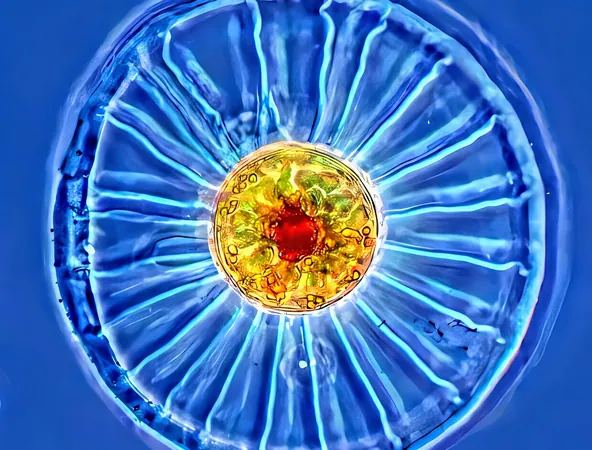
How Light-Sensing Molecules Help Diatoms Navigate Changing Oceans
2025-01-07
Author: Rajesh
In the vast expanse of our oceans, an incredible ecological narrative unfolds largely orchestrated by light-sensing molecules known as phytochromes. Found in the tiny yet mighty phytoplankton, these molecular sensors allow these organisms to adapt and flourish in the constantly shifting aquatic environments they inhabit.
Phytoplankton not only form the cornerstone of marine food webs but also play a pivotal role in maintaining our planet's climate. By absorbing carbon dioxide (CO2) from the atmosphere and generating roughly half of the oxygen we breathe through photosynthesis, phytoplankton are indispensable to life on Earth. However, up to now, the precise mechanisms behind their distribution and behavior have remained a captivating mystery, inciting ongoing research in marine biology.
Diatoms and Their Built-in Light Detection Systems
A collaborative study by scientists from CNRS and Sorbonne University has shed light on the movements of these minuscule organisms, specifically focusing on diatoms—one of the primary groups of phytoplankton. The researchers discovered that diatoms possess an intrinsic light detection system that is encoded into their genomes. These light-sensitive pigments, phytochromes, act like microscopic “eyes,” enabling diatoms to detect fluctuations in light spectra at various water depths, effectively allowing them to gauge their vertical location in the water column.
This ability is critical, particularly in turbulent environments such as polar and temperate regions, where water mixing is intense. Armed with this sensory information, diatoms can adjust their photosynthetic activities to maximize survival.
Biological Clocks in the Deep
The investigation delved deeper into marine genomic data collected during sampling expeditions and revealed a striking pattern: phytochromes were exclusively present in diatoms located in areas outside the Tropics of Cancer and Capricorn. These regions experience notable variations in day length, hinting at a clear seasonal pattern. This finding suggests that phytochromes may serve a dual purpose—not only enhancing light detection for navigation but also acting as biological clocks that allow diatoms to measure seasonal changes.
Revolutionizing Our Understanding of Phytoplankton Behavior
Published in the prestigious journal Nature, the research offers fresh insights into how phytoplankton perceive light and respond to their environment. Understanding these adaptive mechanisms is crucial, especially as environmental changes continue to threaten marine ecosystems. The research showcases the role of phytochromes beyond mere light detection; they could also improve the efficiency of photosynthesis in diatoms. By responding to the dynamic light conditions, these organisms can optimize energy conversion, vital for survival in unpredictable waters.
The Global Significance of Phytoplankton
Phytoplankton, though microscopic, wield immense power over our planet's ecosystems. They provide sustenance to various marine species, from tiny zooplankton to the vastest whales. Beyond their ecological contributions, they act as natural mitigators of climate change by sequestering vast amounts of CO2. Nonetheless, human-induced challenges like climate change, pollution, and ocean acidification drastically affect phytoplankton populations, which in turn threaten the stability of marine ecosystems.
Preserving the health of phytoplankton is thus essential. It goes beyond marine conservation; it is fundamentally about safeguarding the climate stability necessary for future generations. By unlocking and understanding the adaptive mechanisms of these tiny organisms, we can explore innovative approaches to leverage their natural abilities to mitigate climate change, potentially making a significant impact on our environment.
Join the Fight to Preserve Our Oceans!
As the research progresses, scientists continue to uncover the mysteries of these remarkable organisms. Their findings not only deepen our understanding of marine life but also emphasize the urgent need for conservation efforts to protect our oceans. After all, in a world grappling with climate issues, unlocking the secrets of phytoplankton might just hold the key to a sustainable future.




 Brasil (PT)
Brasil (PT)
 Canada (EN)
Canada (EN)
 Chile (ES)
Chile (ES)
 Česko (CS)
Česko (CS)
 대한민국 (KO)
대한민국 (KO)
 España (ES)
España (ES)
 France (FR)
France (FR)
 Hong Kong (EN)
Hong Kong (EN)
 Italia (IT)
Italia (IT)
 日本 (JA)
日本 (JA)
 Magyarország (HU)
Magyarország (HU)
 Norge (NO)
Norge (NO)
 Polska (PL)
Polska (PL)
 Schweiz (DE)
Schweiz (DE)
 Singapore (EN)
Singapore (EN)
 Sverige (SV)
Sverige (SV)
 Suomi (FI)
Suomi (FI)
 Türkiye (TR)
Türkiye (TR)
 الإمارات العربية المتحدة (AR)
الإمارات العربية المتحدة (AR)